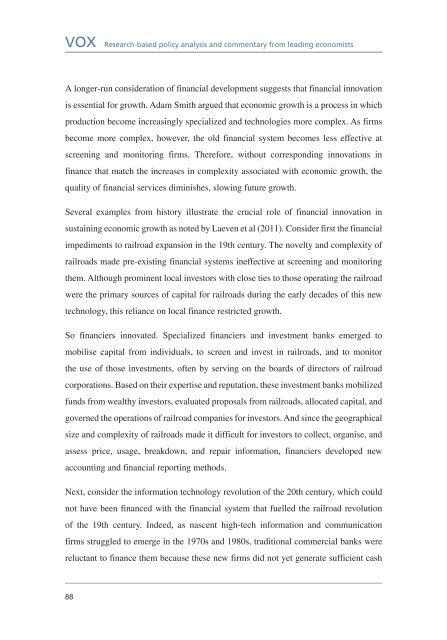Create successful ePaper yourself
Turn your PDF publications into a flip-book with our unique Google optimized e-Paper software.
VOX Research-based policy analysis and commentary from leading economists<br />
A longer-run consideration of financial development suggests that financial innovation<br />
is essential for growth. Adam Smith argued that economic growth is a process in which<br />
production become increasingly specialized and technologies more complex. As firms<br />
become more complex, however, the old financial system becomes less effective at<br />
screening and monitoring firms. Therefore, without corresponding innovations in<br />
finance that match the increases in complexity associated with economic growth, the<br />
quality of financial services diminishes, slowing future growth.<br />
Several examples from history illustrate the crucial role of financial innovation in<br />
sustaining economic growth as noted <strong>by</strong> Laeven et al (2011). Consider first the financial<br />
impediments to railroad expansion in the 19th century. The novelty and complexity of<br />
railroads made pre-existing financial systems ineffective at screening and monitoring<br />
them. Although prominent local investors with close ties to those operating the railroad<br />
were the primary sources of capital for railroads during the early decades of this new<br />
technology, this reliance on local finance restricted growth.<br />
So financiers innovated. Specialized financiers and investment banks emerged to<br />
mobilise capital from individuals, to screen and invest in railroads, and to monitor<br />
the use of those investments, often <strong>by</strong> serving on the boards of directors of railroad<br />
corporations. Based on their expertise and reputation, these investment banks mobilized<br />
funds from wealthy investors, evaluated proposals from railroads, allocated capital, and<br />
governed the operations of railroad companies for investors. And since the geographical<br />
size and complexity of railroads made it difficult for investors to collect, organise, and<br />
assess price, usage, breakdown, and repair information, financiers developed new<br />
accounting and financial reporting methods.<br />
Next, consider the information technology revolution of the 20th century, which could<br />
not have been financed with the financial system that fuelled the railroad revolution<br />
of the 19th century. Indeed, as nascent high-tech information and communication<br />
firms struggled to emerge in the 1970s and 1980s, traditional commercial banks were<br />
reluctant to finance them because these new firms did not yet generate sufficient cash<br />
88














